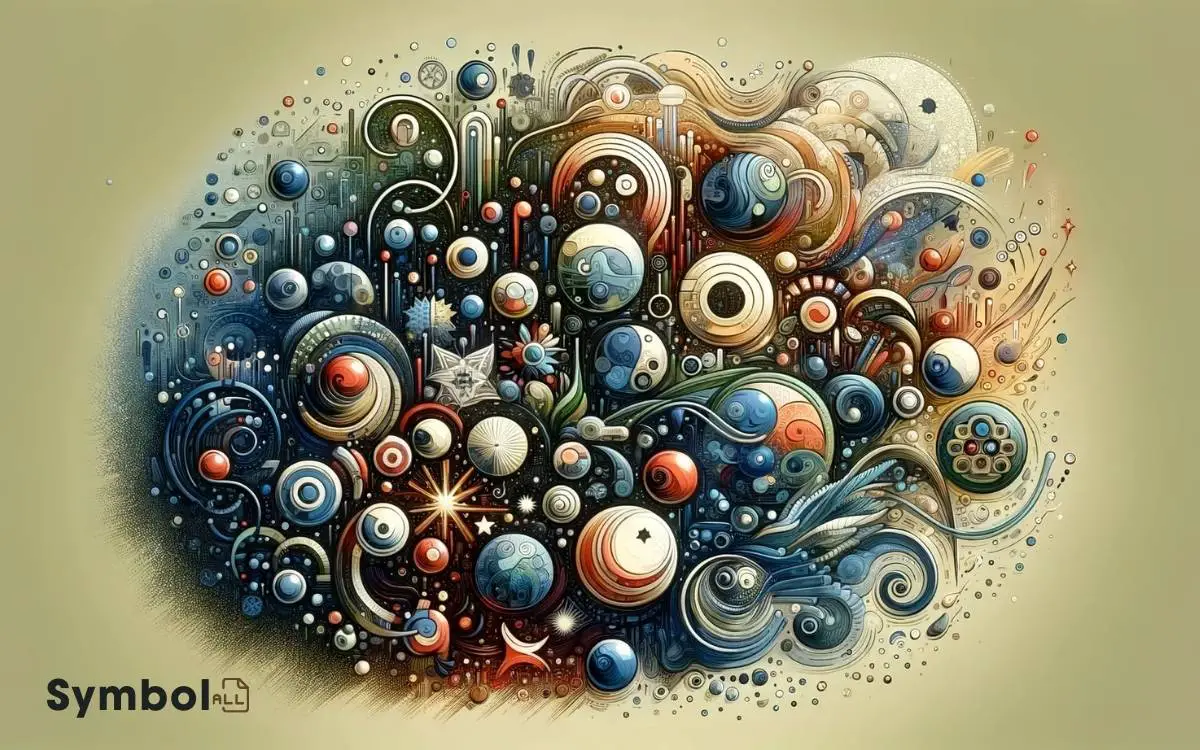Symbolism Used in a Sentence: Explains!
Symbolism enriches a sentence by layering it with deeper meanings. When you grasp a symbol, you’re not just seeing words; you’re uncovering concealed messages.
Think of it as a bridge to the underlying themes. Being an active reader is essential; symbols don’t reveal themselves without your engagement. They express complex ideas succinctly, adding depth to your understanding.
For instance, describing someone as having ‘a heart of gold’ isn’t about wealth but about profound kindness.
Symbols invite you to look beyond the surface, making the narrative resonate on multiple levels. As you become adept at spotting symbols, you’ll discover more insightful connections.

Key Takeaways
Understanding Symbolism
Symbolism, a potent literary tool, enriches narratives by imbuing objects, characters, or events with deeper, often hidden, meanings, inviting you to explore beyond the surface to uncover the layers of significance embedded within a story.
When you investigate into symbolism, you’re not just reading; you’re interpreting, seeking out the connections that transform the ordinary into the extraordinary.
Symbols can serve as bridges, linking you to the thematic undercurrents of the narrative. They can be as simple as a color or as intricate as an entire character, each carrying weight and contributing to the story’s richness.
Understanding symbolism requires you to be an active reader, one who questions and connects, piecing together the puzzle the author has laid out. This analytical approach opens up a world of insight, making every reading experience uniquely profound.
The Basics of Symbolism
Before delving into the intricate layers of symbolism, it’s imperative to grasp its foundational principles, which serve as the building blocks for understanding how symbols function within a narrative.
At its core, symbolism allows you to express complex ideas and emotions through objects, characters, or colors that carry deeper meanings beyond their literal sense.
It’s a way to convey abstract concepts without explicitly stating them, adding depth and layers to your understanding.
Recognizing symbols requires you to look beyond the surface, considering the context and the broader implications of these elements. By doing so, you engage with the material on a more profound level, uncovering nuances and connections that mightn’t be immediately apparent.
This foundational knowledge equips you to appreciate the subtleties and richness of symbolism as you encounter it.
Symbolism in Literature
You’ll find that literature brims with symbols, where characters and themes often carry deeper meanings than what’s on the surface.
Analyzing metaphorical language reveals the intricate ways authors weave concepts and emotions into their narratives.
Imagery, in turn, paints vivid pictures that resonate with symbolic significance, enriching your understanding of the text.
Symbolic Characters and Themes
Many literary works employ symbolic characters and themes to convey deeper meanings and insights, inviting you to explore the layers beyond the surface narrative.
Symbolic characters often embody universal concepts or societal critiques, acting not just as individuals in their stories but as representations of broader ideas.
For instance, a character might symbolize innocence, corruption, or freedom, serving as a living metaphor within the text. Similarly, themes woven with symbolism can offer nuanced perspectives on complex issues like love, war, or the human condition.
Metaphorical Language Analysis
Exploring metaphorical language analysis reveals how authors use symbolism to infuse their narratives with layers of meaning that resonate deeply with readers. Through this intricate dance of words, you uncover the hidden depths within a story.
It’s not just about the surface narrative; it’s about what lies beneath. When a character is described as having a ‘heart of stone,’ it isn’t simply about their emotional state. It symbolizes a deep-seated unwillingness to change or feel.
This analysis isn’t superficial. It requires you to uncover the layers, to question and to delve deeper. As you investigate, you’ll find that metaphorical language isn’t just a tool for embellishment.
It’s a bridge connecting the tangible with the abstract, offering insights into the human condition and the world around us.
Imagery in Literary Works
Exploring imagery in literary works reveals how authors craft vivid, symbolic landscapes that resonate with readers on a profound level. When you immerse yourself in the pages of a novel, it’s not just the plot that moves you, but the imagery that paints a picture in your mind.
This technique involves using descriptive language that appeals to your senses, allowing you to see, hear, smell, touch, and sometimes taste the story’s environment.
It’s a powerful tool for symbolism, where objects or elements aren’t just themselves but represent deeper meanings or themes.
Through imagery, authors give life to abstract ideas, making them tangible and relatable. This not only enhances the narrative but also deepens your connection with the text, inviting you to explore layers of meaning beyond the surface.
Common Symbols and Meanings
Understanding common symbols and their meanings can deepen your appreciation of literature, as these symbols often reveal layers of significance beyond their surface interpretation.
By recognizing these symbols, you’re not just reading; you’re engaging in a dialogue with the author and the traditions from which they draw. Let’s explore some common symbols and their associated meanings.
| Symbol | Meaning |
|---|---|
| Water | Life, purification, or renewal |
| Light | Knowledge, hope, or enlightenment |
| Darkness | Ignorance, despair, or evil |
| Fire | Passion, transformation, or danger |
| Bird | Freedom, transcendence, or a messenger |
Each symbol serves as a key to unraveling deeper meanings within a text. By examining these symbols, you’re equipped to investigate the nuanced layers of storytelling and thematic development, enriching your literary journey.
Crafting Symbolic Sentences
To craft symbolic sentences, you first need to understand what symbolic language entails and how it functions within a narrative.
Analyzing examples from literature can illuminate how seasoned writers embed symbolism to add depth and universality to their work.
Defining Symbolic Language
Symbolic language weaves intricate meanings into sentences, inviting you to decipher layers beyond the literal text. It’s a craft that demands not only a deep understanding of the words themselves but also of the broader cultural, historical, and emotional contexts they inhabit.
You’re not just beginning; you’re entering into the domain of the unsaid, where meanings aren’t handed to you but discovered through insight and reflection.
This form of communication relies heavily on metaphor, allegory, and allusion, transforming straightforward statements into rich, multi-faceted expressions.
It’s about conveying more with less, using symbols to express complex ideas, emotions, or values in a nuanced, often poignant way.
As you engage with symbolic language, you’re venturing into the domain of the unsaid, where meanings aren’t handed to you but discovered through insight and reflection.
Examples in Literature
Exploring symbolic language further, let’s examine how literature employs crafted sentences to convey rich, layered meanings beyond their surface interpretation.
Authors often weave symbols into their narratives to evoke emotions, develop themes, or impart deeper insights.
For instance, in F. Scott Fitzgerald’s ‘The Great Gatsby,’ the green light at the end of Daisy’s dock represents Gatsby’s unattainable dreams and the American Dream’s elusive nature.
Similarly, in George Orwell’s ‘Animal Farm,’ the windmill symbolizes the pigs’ manipulation and the corruption of ideals.
These symbols aren’t just decorative elements; they’re integral to understanding the characters’ motivations and the narrative’s underlying messages.
By paying attention to how symbols are crafted into sentences, you’ll uncover layers of meaning that enhance your appreciation of literary works.
Techniques for Symbolism
Mastering the art of crafting symbolic sentences requires an understanding of various literary techniques that can subtly embed deeper meanings within a text.
You’ll need to familiarize yourself with metaphor and simile, as they’re foundational in exploring abstract concepts to tangible elements, enriching your narrative with layers of significance.
Immerse yourself in allegory for longer narratives, where characters, events, or settings serve as symbols, conveying complex ideas through a parallel storyline.
Don’t overlook the power of motifs, recurring elements that reinforce the theme and amplify symbolism. Pay attention to symbolism’s context, ensuring it aligns with your narrative’s tone and theme.
Symbolism in Everyday Language
In everyday language, you often encounter symbols that convey deeper meanings beyond their literal interpretation. Phrases like ‘a heart of gold‘ don’t depict a literal golden heart but symbolize immense kindness and generosity.
This usage of symbolism enriches communication, allowing you to express complex ideas and emotions succinctly. By leveraging symbols, you can convey profound meanings that transcend literal interpretations, fostering deeper connections with your audience. For instance, metaphors and imagery can evoke powerful emotions or highlight abstract concepts in ways words alone often cannot. If you’re wondering how to use symbolize in a sentence, consider explaining how a dove symbolizes peace or how a flame might represent passion or resilience.
For instance, saying someone has ‘cold feet‘ isn’t about temperature but symbolizes fear or hesitation. These symbols, deeply embedded in language, offer a shortcut to understanding and empathy, bridging gaps between diverse experiences and perceptions.
They’re not just linguistic flourishes but tools that enhance the depth and breadth of everyday conversations.
The Power of Visual Symbols
Visual symbols wield immense power, often communicating complex ideas and emotions more effectively than words alone can. You’ve experienced this when a simple image a heart, a dove, a clenched fist evokes a deep emotional response or conveys a multifaceted concept.
These symbols transcend linguistic barriers, allowing for a universal language of sorts. They’re not just static images; they’re dynamic, evolving with societal changes yet retaining a core meaning.
Consider how logos or brands use visual symbols to not only represent their identity but also to instill a certain feeling or association in you.
It’s a confirmation of the symbols’ ability to convey not just information, but also values, aspirations, and identities, making them an indispensable tool in communication.
Symbolism in Historical Contexts
Throughout history, symbols have often served as powerful vehicles for conveying complex ideologies, emotions, and identities, shaping cultural narratives and collective memory.
You’ve seen national flags stir patriotism, religious icons evoke profound spiritual reverence, and simple gestures encapsulate powerful social movements.
These symbols aren’t just static images or objects; they’re dynamic, evolving with societal changes and embodying the hopes, fears, and dreams of a culture.
They bridge personal experiences with communal stories, creating a shared understanding that transcends language barriers.
Interpreting Symbolic Language
Delving into symbolic language, you’ll uncover layers of meaning that often escape first glance, revealing how words and phrases can embody complex ideas, emotions, and cultural narratives.
| Symbol | Implied Meaning |
|---|---|
| Dove | Peace or purity |
| Chains | Oppression or restriction |
| Spring | Rebirth or new beginnings |
| Storm | Conflict or turmoil |
| Crossroads | Decision point or life change |
Interpreting symbolic language requires you to reflect on context, cultural background, and the nuances of human expression. It’s an analytical process, where you decode the hidden messages woven into sentences.
By doing so, you engage more deeply with the material, peeling back the layers to uncover the rich tapestry of meaning that authors, orators, and even everyday conversations convey.
Symbolism in Poetry
In the domain of poetry, symbols serve as the backbone, weaving complex narratives that resonate on a deeply personal level. Through the use of symbols, poets are able to convey emotions, ideas, and themes that might otherwise be difficult to articulate.
You’ll find that symbolism in poetry:
- Transforms ordinary objects into profound representations of larger themes.
- Allows for multiple interpretations, enriching the reading experience.
- Bridges the gap between the tangible and the abstract, making abstract ideas more accessible.
This intricate use of symbols invites you to dive deeper into the text, uncovering layers of meaning with each read. It’s not just about what’s on the surface; it’s about what lies beneath, waiting to be discovered.
Symbolism in poetry doesn’t just tell a story; it invites you into a world of heightened understanding and connection.
Techniques for Creating Symbolism
You must understand that the symbols you choose carry weight far beyond their surface meanings; their significance can alter the tone and depth of your narrative.
By carefully selecting symbols that resonate on multiple levels, you’re able to weave a richer tapestry of meaning, enhancing your story’s emotional and intellectual appeal.
The context in which these symbols are placed further amplifies their impact, making each sentence a potential minefield of interpretations and insights.
Symbol Choice Importance
Choosing the right symbol in a literary piece can greatly amplify its thematic depth and emotional resonance, guiding readers toward deeper insights.
When you’re selecting symbols, you’re not just picking arbitrary images or objects; you’re embedding layers of meaning into your narrative. Each symbol serves as a beacon, illuminating paths to understand your story’s core themes and emotions.
- Universality: The best symbols resonate across cultures and time, tapping into universal human experiences.
- Specificity: While being universal, they must also be specific enough to enrich your narrative, adding layers without ambiguity.
- Evocative Power: Symbols should evoke emotions or associations, painting mental images that stick with readers long after they’ve turned the last page.
Through careful selection, symbols become more than literary devices; they transform into the soul of your story, connecting deeply with your audience.
Contextual Symbolism Impact
Why should symbols be carefully woven into your narrative’s fabric, and how can their contextual placement amplify your story’s impact?
When you embed symbols within the right context, they don’t just add depth; they resonate with your audience on a more profound level. It’s about selecting symbols that not only fit the narrative’s setting but also evolve with the storyline.
This technique guarantees that the symbolism grows in significance, mirroring character development and plot twists.
Symbolism Across Cultures
Symbolism, a universal thread woven through the tapestry of human culture, varies significantly from one society to another, reflecting diverse beliefs, values, and histories. You’ll find that symbols you’re familiar with might carry completely different meanings elsewhere.
- The Lotus Flower: In Eastern cultures, it symbolizes purity and enlightenment, emerging unscathed from murky waters. Contrastingly, in ancient Egyptian mythology, it represented the sun’s rebirth, due to its daily bloom cycle.
- The Eagle: Esteemed in the United States for its association with freedom and strength, whereas in some Native American cultures, it’s revered as a sacred messenger between humans and the spiritual world.
- The Color White: Symbolizing purity and peace in many Western cultures, yet it represents mourning and death in many Eastern societies.
These examples underscore the rich, varied interpretations of symbols globally, urging a deeper understanding beyond one’s cultural lens.
Conclusion
In sum, you’ve journeyed through the rich landscape of symbolism, from its foundational concepts to its intricate application across cultures.
Imagine symbolism as a bridge connecting the seen with the unseen, the known with the mysterious.
Just as a single leaf can signify the unstoppable force of nature, your understanding of symbolism allows you to reveal deeper meanings in literature, art, and beyond.
You’re now equipped to peel back the layers of even the most complex symbolic expressions, exposing the core of human experience beneath.






